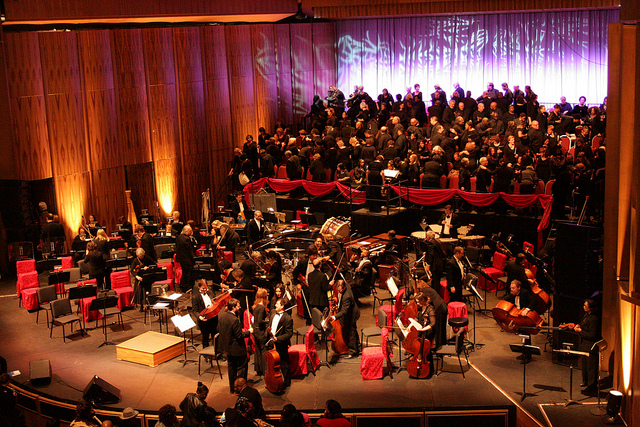
Akron Symphony Orchestra introduces ‘Sounds of Akron’ composer in season opener

Akron Symphony Orchestra. Photo courtesy of ASO.
The Akron Symphony Orchestra, a Knight Arts grantee, will kick off its new season on Sept. 19 with a concert it’s calling “American Journey.” The evening will feature a complete version of “Rodeo” by well-known 20th-century American composer Aaron Copland, as well as a newer work, “Southern Air,” by Cleveland-based composer Clint Needham. The evening’s performance will also feature guest pianist Philip Thomson, an associate professor at The University of Akron’s School of Music, playing George Gershwin’s Concerto in F.
It won’t be Thomson’s first time to play for the orchestra, nor his only time to perform Gershwin’s concerto at a symphony performance. In a recent telephone interview, Thomson said he had played “a couple of times” for the Akron Symphony Orchestra. He was featured one year playing “Le Tombeau de Liberace,” a work for piano and chamber orchestra by contemporary composer Michael Daugherty, and a few years later he performed the only concerto penned by Edvard Grieg, his Piano Concerto in A minor.
When asked how the opportunity for the upcoming concert came about, the artist said the chance “came completely out of the blue.” Thomson received an email asking him to perform the work, and instantly agreed.
Gershwin’s Concerto in F, it turns out, is “one of my favorites of all time,” Thomson was quick to say. When a young graduate student, Thomson was asked to prepare the work for an orchestra in the western reaches of his native Canada. Thomson appreciates the rhythms, the dance-like quality and the energy of the piece. He is looking forward to playing it again.
Thomson told the story of how Gershwin came to write the concerto. A year after he had hurriedly finished “Rhapsody in Blue” in 1924 and had considerable success with it, Gershwin was asked to compose a proper concerto. It seems the artist had “no time” for “Rhapsody in Blue,” as Thomson commented, to really do justice by the work. “It’s rough in spots,” Thomson added.
With Concerto in F, however, Thomson said that Gershwin “outdid himself.” Not schooled in concerto form, Gershwin obtained books that described how a concerto is put together and made to work musically. His efforts apparently paid off, for as Thomson commented, this work stands alongside Gershwin’s “An American in Paris” as his best work.
Thomson will no doubt do great justice to the concerto. This biography on the Canadian Encyclopedia notes that Thomson “has been praised for his virtuosity, accuracy, brilliance and tone quality” at the piano. Anyone who has heard him perform will understand what the critics were getting at, especially the comments about tone quality, which is remarkably clear, resonant and evocative.
During the interview, when asked if he practiced the way he struck the keys, Thomson said he did not. He added that he plays the way he has always played, but that the quality comes from what he called “an affinity for the touch of the piano.” He described his playing in terms of becoming as “one with the piano, not different from it, but like becoming part of it.”
All that shows up in his playing. Thomson knows the sound quality, or musical color, that can come from how he strikes a key. He said that he tries to touch keys “as they should be struck.” As an example, he described a work he played where the first and fourth sections began on a single note, an E up a few octaves from classic middle C. In the opening bar, he hit the key with his fourth finger, using the fleshy part to strike it. In the fourth section, he struck the same note, only this time using the tip of his third finger. Each produces, he said, a different quality or emotion. The first was as though one “were touching a loved one, a spouse,” he noted. The second was more “playful, as though poking a friend in the rib.”
Such subtleties illustrate an artist who not only knows his instrument, but understands it–and his relationship to it. His technique should show well in a piece like the Concerto in F, which has many musical moods.
Thomson is probably best known for his playing of Franz Liszt. “I’ve recorded more of it” than works by other composers, he noted, including for the online music repository Naxos. And Thomson is highly regarded for discovering and playing the complete Preludes and Impromptus of almost forgotten composer Felix Blumenfeld. Thomson has revived that musical literature.
As to his favorite composers, Thomson said he favors Frédéric Chopin and Sergei Rachmaninoff, among many others. “If someone put a gun to my head, I wouldn’t hesitate to say Bach,” he admitted, as the overall winner. The music of Johann Sebastian Bach, he concluded, contains “everything that exists in music.” Although Thomson said he doesn’t have a huge musical collection on CD, he noted that the first one he bought was of Bach’s Brandenburg Concertos.
Needham, the other area musician that will featured at the concert, is a composer-in-residence and assistant professor of music at Baldwin Wallace University. He has been commissioned to create a new composition funded by Knight Foundation that will utilize crowdsourced sounds from the Akron area. Through mid-November, the community may record and submit sounds using the Sounds of Akron smartphone app. The end result will be a symphonic portrait of Akron as composed by Needham, to be performed by the Akron Symphony Orchestra in April of 2016.
Akron Symphony Orchestra will present “American Journey” at 8 p.m. on Saturday, Sept. 19 in Akron’s E.J. Thomas Performing Arts Hall. Tickets are available online.
Recent Content
-
Artsarticle ·
-
Artsarticle ·
-
Artsarticle ·
